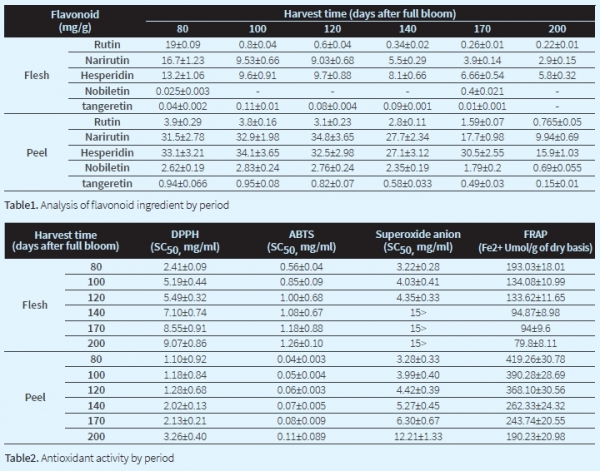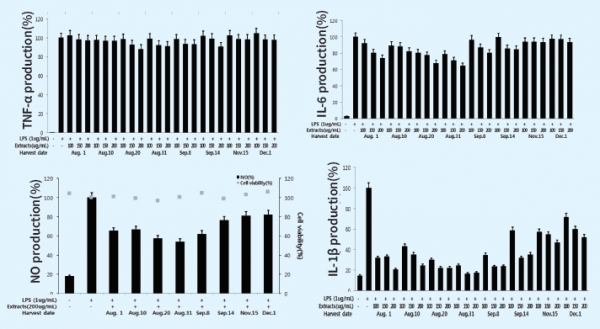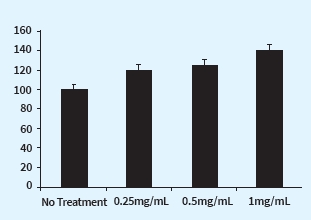Sang-sook, Kim (Agricultural researcher of Citrus Research Institute)
ABSTRACT
The green mandarin, the premature satsuma mandarin which is harvested between August 15 and September 15, contains a large number of useful ingredients. Therefore, we investigated its utilization as a functional material.
The total polyphenol content of green mandarin is 19.59g/100g in the peel and 4.01g/100g in the flesh. This is 2.3 times higher in the peel and 1.9 times higher in the flesh when compared to the peel (8.34g/100g) and flesh (2.11g/100g) of fully ripe fruit harvested in mid-November. Besides, the total flavonoid contents of green mandarin were 10.124g/100g in the peel and 0.222g/100g in the flesh. This is 2.3 times higher in the peel and 32 times higher in the flesh when compared to the peel (4.442g/100g) and flesh (0.0068g/100g) of fully ripe fruit. The contents of narirutin and hesperidin, the major flavonoid ingredients of mandarin, were 348 ppm and 326 ppm in green mandarin, higher than 99 ppm and 158 ppm in fully ripe fruit, respectively. In particular, the contents of nobiletin and tangeretin, the polymethoxyflavones contained only in citrus fruits, were 4 times higher was 4 times higher in green mandarin (28 ppm and 9 ppm, respectively) than in fully ripe fruit (7ppm and 1.5ppm, respectively). Like this, it has been shown that the functional ingredient content of green mandarin has a higher antioxidant activity comparing to ripened fruit. Also, the ability to remove the superoxide anion radicals, which was generally known to occur most commonly in the body, was more than 4 times higher in green mandarin than fully ripe fruit. Good antioxidant activity is an important factor in making healthy and elastic skin.
The green mandarin extract was also confirmed to increase the production of hyaluronic acid that affected wrinkles and elasticity as a skin moisturizing factor. Besides, the inhibitory effect on the production of NO nitric oxide and inflammatory cytokines, the representative indicators of the inflammatory response, was observed using macrophage RAW264.7 that has gotten inflammation by inflammatory factor LPS. As a result, NO production was reduced by 40% when treated with 200 ug/mL of green mandarin extract.
The production of TNF-a, IL-1B, and IL-6 among inflammatory cytokines was inhibited by 10%, 80% and 35%, respectively. As a result of this study, it is considered that the green mandarin can be used as a cosmetic material for antioxidant, anti-inflammation and moisturizing effects.

Research background
Premature citrus contains more organic acids, dietary fiber, polyphenols, and flavonoids than full ripe mandarin, and thus it has high value as a functional material. However, most of the premature mandarins were thrown away during thinning fruits. A lot of fruits were thinned out every year. Therefore, it is required to develop processed products using these fruits; however, it is not economically feasible yet compared to the efforts of thinning fruits.
On June 13, 2016, the ‘Act on Citrus Production and Distribution in Jeju Special Self-Governing Province‘ which includes permission to distribute ‘Premature mandarin‘ has been amended/approved. Accordingly, the Korean name of premature mandarin was changed from ‘Chung-gyul‘ to ‘Put-guyl‘.
And the distribution was also allowed for premature field mandarin from Aug. 15 to Sep. 15, the duration which does not overlap with the distribution period of very early-maturing satsuma mandarin.
It is required to develop technology to improve the added value of premature mandarin. Therefore, in response to the increase of natural products related to the recent trend of cosmetics industries, we have tried to develop premature mandarin as a functional cosmetics material.
Late June Mid-July Early August Late August Mid-September Late October Late November The production of TNF-a, IL-1B, and IL-6 among inflammatory cytokines was inhibited by 10%, 80% and 35%, respectively. As a result of this study, it is considered that the green mandarin can be used as a cosmetic material for
antioxidant, anti-inflammation and moisturizing effects.

Research details
Analysis of flavonoid ingredients using HPLC
We analyzed flavonoid ingredients after dividing them into the flesh and the peel by period. The content of flavonoids was higher in the peel than in the flesh and decreased as the fruit matured. The content of nairutin and hepsperidin in the flesh and the peel was high and then decreased in the fruit matured. In particular, it was confirmed that the flavonoid contents were maintained high at 80, 100 and 120 days after full bloom between from Aug. 15 to Sep. 15. Also, the contents of nobliletin and tangeretin, polymethoxy flavonoids known to be contained only in citrus fruits, were high in the peel, and rapidly decreased from 120 days after full bloom. By analyzing the flavonoid ingredients, it is suggested that the period from Aug. 15 to Sep. 15 is appropriate for shipping premature mandarin to use them as functional ingredients.
Measurement of antioxidant activity
DPPH, ABTS and superoxide radical scavenging activity and FRAP were measured for measuring antioxidant activity. Radical scavenging activity was determined by measuring the value of concentration at which the radical was reduced by 50% (SC50). The results showed that antioxidant activity was highest at 80 days after full bloom, and the activity decreased as it matured. Especially, the activity was high in the peel part that had a high content of polyphenol. However, in the case of superoxide radical scavenging activity, it was similar in the flesh and peel of premature mandarin, which suggested that other ingredients than polyphenol affected the activity.

Anti-inflammatory activity
Also in the measurement of anti-inflammatory activity, the inhibitory effect of NO and inflammatory cytokine production was highest between Aug. 1 and Aug. 30, especially at Aug. 20 and Aug. 31. In the case of inhibiting inflammatory cytokine production, the inhibitory effect on IL-1β production was highest, and the inhibitory effect on TNF-α was relatively low.

Measurement of the moisturizing factor, hyaluronic acid production
In order to investigate the moisture-increasing activity of the premature mandarin extract, HaCaT cells, a human keratinocyte, were used for the experiment. As a result, it was confirmed that the production of hyaluronic acid, a moisturizing factor, increased by 40% without toxicity in HaCaT cells.
The increase in hyaluronic acid production is thought to increase the moisture retention by capturing moisture of the skin, and may also affect the wrinkle improvement and elasticity of the skin.

